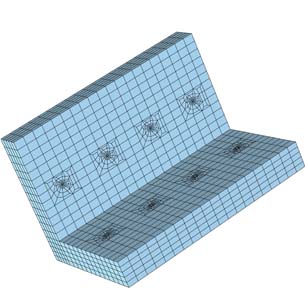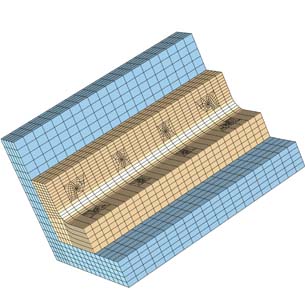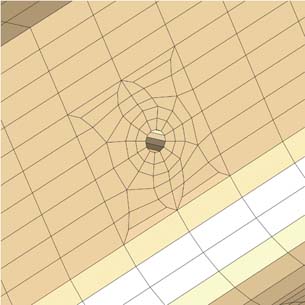September 2, 2010
By DE Editors
September 2, 2010 - The new automatic rivet hole feature in TrueGrid will be available in the next release of TrueGrid, scheduled to be released on October 1, 2010. With this new feature, one simply identifies the location and size of the hole. This new automatic feature will insert a hole and adjust the mesh in the neighborhood of the hole to maintain a high quality hexahedral mesh. Typically, one will apply this new feature to several parts so that the rivet part can bind several parts together. Nodes around the hole are aligned in both parts. This makes it possible to insert a mesh of a rivet so that the nodes of the rivet will also align with both parts. The user has full control of the process so that the coincident nodes at the interface between the rivet and the other parts can either be merged, given shared degrees of freedom, or used to form opposite sides of contact surfaces.
 |  |
When constructing a part in TrueGrid, such as a panel of an aircraft fuselage, the HOLE command is applied to both the panel part and the frame part. In the example below, a vertical and horizontal plate are joined using a filleted brace. Four rivet holes are placed in the horizontal plate and four rivet holes are placed in the vertical plate. The pictures show how some of the hex elements that form the structured mesh have been replaced by a group of unstructured hex elements to transition the mesh from the structured mesh to the hole. Around the hole is an annulus of uniformly distributed hex elements.
 |
The same procedure is applied to the brace part. The nodes at the interface between the parts, which form the annulus, match. These nodes are aligned so that a rivet part can be inserted and merged to the other parts, if needed. The annulus is optional and is important to maintain the highest quality mesh in the region of highest stress.
One can also do the following with the HOLE command:
1. Both an inner and outer radius can be specified for the hole. In this case and annulus with a circular row of hexahedral elements are formed around the hole. The elements are equally spaced with mesh lines radiating outward from the center or axis of the cylinders.
2. The number of hexahedral elements in the annulus in the radial direction can be specified (defaults to one element).
3. Many holes can be grouped together and a hexahedral mesh is automatically formed that fills the small gaps between the holes, avoiding the need to transition from a hole to the mesh of the parent part and then transition again to a neighboring hole.
Subscribe to our FREE magazine, FREE email newsletters or both!
About the Author
DE’s editors contribute news and new product announcements to Digital Engineering.
Press releases may be sent to them via [email protected].






